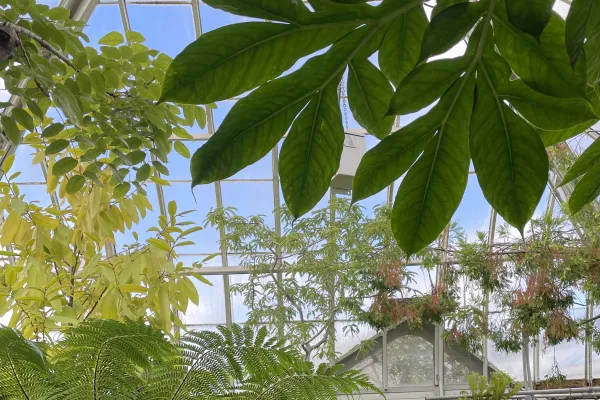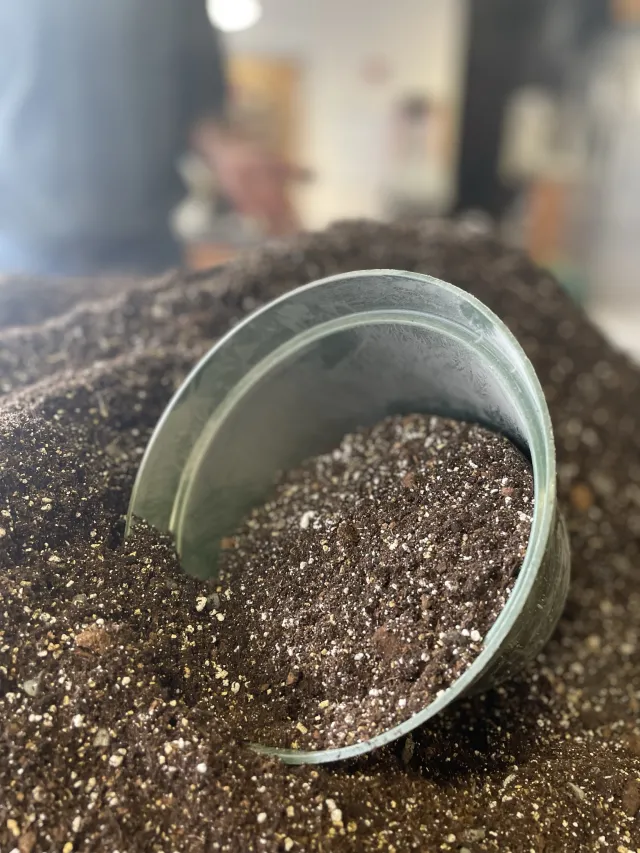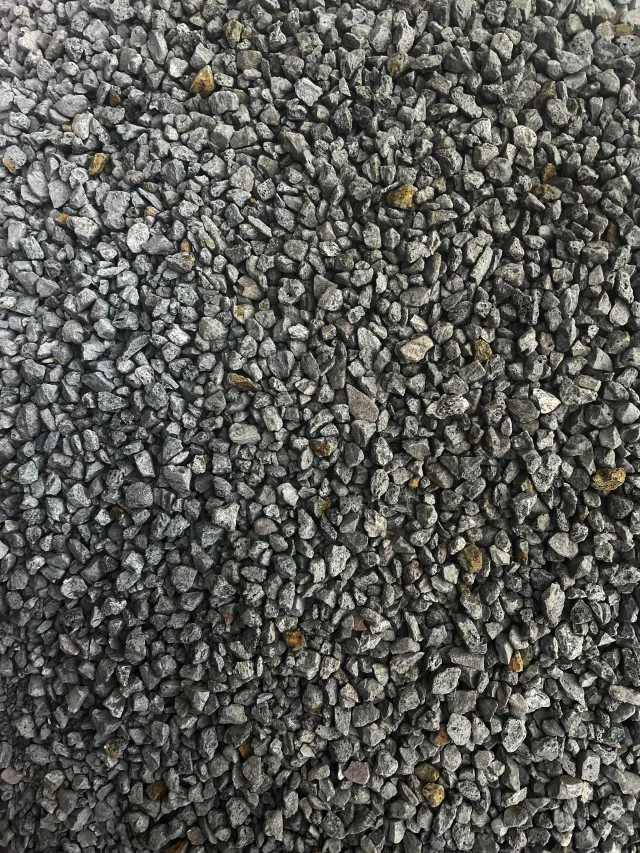How To Water Everybody at the Same Time When Nobody Is on Anybody Else’s Schedule
By Conservatory Curator Jimmy Grogan

Published March 20, 2024
Leaflet 2023
Lyman Plant House is a big glass machine for growing plants from around the world. In its 12 separate houses we vary temperatures and watering regimes to approximate the environments these plants would encounter if they were at home in the wild. The trickiest part of the magic trick that is a happy, healthy collection of over 2,200 species of plants is water.
Every plant species requires water at rates through the seasons specific to its needs, needs which have been baked into its genetic code through evolutionary time by the seasonal availability (or not) of water in the place on Earth it calls home. Because every place is different from every other, no two plants share the same relationship to water.
How, then, can we water hundreds of plants at the same time when each individual plant needs a different amount of water and has a different tolerance for wet or dry soils? We do this by fiddling with the potting medium each plant’s roots encounter in the pot or ground where it lives in Lyman by mixing potting media on a spectrum of coarse to fine—meaning fast- to slow-draining—so that all the plants are equally “dry” at each watering.
To understand this better, we need to examine the ways that true soil and greenhouse potting media differ. Soil is a complex, living entity highly specific to place and time, composed in varying proportions of four main components: broken-down bedrock in a mix of tiny pieces called sand, silt and clay; organic matter, compliments of decomposing life; water, except under extremely dry conditions; and air space, a consequence of physical components fitting loosely up against each other. Soil is dense and heavy because it is full of stones and water, but the air spaces allow roots to penetrate and breathe.

An industrial potting medium, like the potting soil that you might buy in a garden supply store, resembles soil but is actually something quite different. It’s a sterile mix of finely shredded sphagnum moss, ground pine bark, perlite (tiny white spongy stones, also known as spongerock) and various other ingredients in small amounts, including slow-release fertilizer to replace the fertility of organic matter in soils. It is feather-light compared to a similar volume of true soil because it lacks bedrock—no sand, silt or clay. The sphagnum moss substitutes for organic matter as a water-holding constituent, though without the metabolic and nutritional benefits that decomposing life provides to growing plants. Like soil, a potting medium holds a plant in place, but it leaves us responsible for adding water and nutrients essential to plant growth.
The key concept in understanding why different soils and potting media hold different amounts of water is texture. In soil, clay, silt and sand particles are orders of magnitude different in size. If clay particles were actually the size of fine gravel, then sand particles by comparison would be the size of boulders strewn across a New England hillside; silt would be the size of the rocks in the crumbling stone walls running through our forests which used to demarcate open pasture fields. The mix of these bedrock components determines how fast water flows through soil, and, to a large degree, which plants live where.
In Palm House, by way of example, it may feel uniformly wet and warm on a winter day’s visit. But we have created drier root zone conditions for some plants by mixing potting media with coarse texture that drains faster than media with fine texture, because no two tropical forests where these plants come from are the same in terms of how wet they are and how much water their soils retain. Even if the total amount of annual rainfall is equal between forests on different continents, the rates at which it falls through the seasons will be different. Equally important, the texture and depth of forest soils will also differ, meaning that one site will be wetter than the other, on average. By mixing some potting soils “drier” than others, we are able to expand the range of plants that can be grown together in a given house under whatever temperature and watering regime prevails in that space.

To do this we add “boulders” in various quantities to our in-house potting mix (which we’ve affectionately named the Special Sauce). By adding lightweight, inert stones or stone-like materials that come in a range of standard sizes—sponge rock, coarse vermiculite, charcoal, kiln-fired clay pellets and especially a gray, stone-like industrial product known generically as stalite—we create potting mixes with rapid drainage and excellent airflow for plants that don’t like wet feet. Plant performance tells us whether we’re getting it right or not, and whether a wetter or drier mix is needed at the next repotting.
As you might expect, the most extreme example of fast-draining soils can be found in Succulent House. We grow cacti in a potting medium that is approximately one-half Special Sauce and one-half stalite. The Special Sauce is wettable, but adding so much stalite ensures that the mix dries quickly, making it perfect for cacti, succulent euphorbias and other plants adapted to arid conditions.
The orchids, bromeliads and other epiphytes in Stove House present yet another potting media puzzle. Epiphytes are plants that grow attached to other plants, often with specialized roots that grow completely exposed to light, air and rain. Many tropical orchids and bromeliads—the “air plants”—find their home high in the forest canopy perched on tree branches in bright sunlight. These plants typically get soaking wet during late-afternoon thunderstorms, but then dry out completely during the next day’s blazing-hot morning and early afternoon. Their roots are adapted to adhere to tree bark, to absorb water when they get very wet, and then to conserve water during the day when their environment turns hot and dry.
In Stove House, you will see many strategies for imitating natural rooting conditions for these beautiful plants. Species that grow highest in the forest canopy, in the most exposed, driest spots, are mounted on cork slabs—cork is bark peeled from a Mediterranean oak tree called Quercus suber—by binding them with fishing line until their roots grow out and naturally attach to the cork mounts. Orchids that want wetter conditions, but still need their roots to dry out daily, are mounted on slabs of fern roots, which hold some water after wetting but also drain quickly. Other orchids that can tolerate even wetter conditions are in pots filled with an “orchid mix” of pine bark, coarse sponge rock and charcoal; by varying the size or grade of these ingredients we can control how fast the mix dries out after watering. In fact, from one potted orchid to the next around the perimeter of Stove House you will find almost as many grades of potting media as plants, calibrated so that we can water them all, almost every day, at the same time. Which of course is our objective in all of Lyman’s houses, whether wet or dry, warm or cool: to calibrate potting media on a plant-by-plant basis to be able to water them all at the same time. We pursue this goal one repotting at a time.